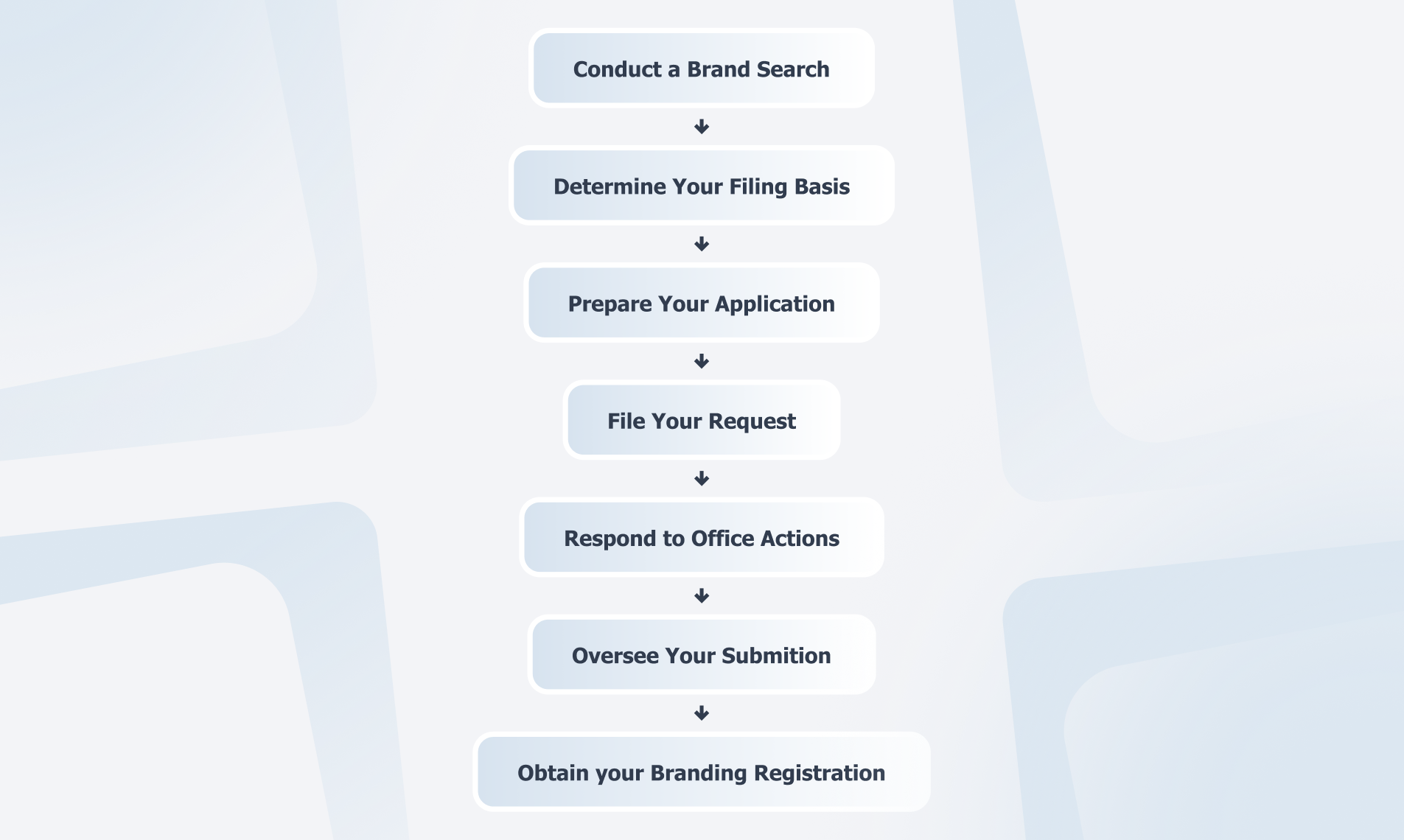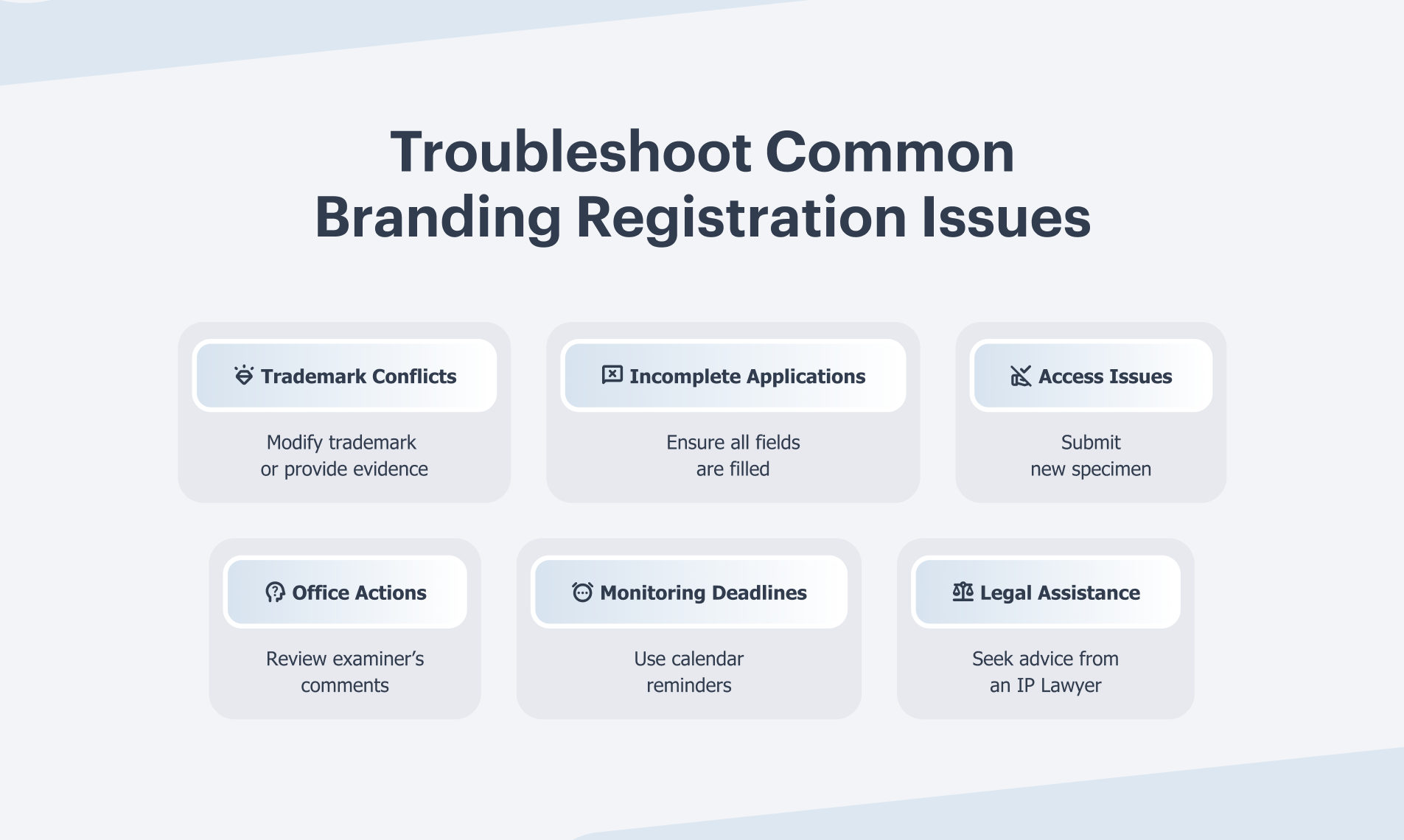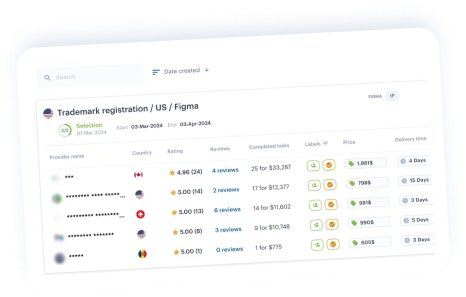Overview
This article presents a comprehensive step-by-step process for the successful registration of a brand, underscoring the crucial importance of legal protection for a company’s identity. It details essential steps such as:
- Conducting a brand search
- Preparing the application
- Responding to potential conflicts
These steps are critical for navigating the complexities of trademark registration and ensuring long-term brand security. By following this process, companies can effectively safeguard their identity and enhance their market position.
Introduction
In a world where brand identity reigns supreme, grasping the intricacies of branding registration is essential for any business aspiring to thrive.
This legal process, commonly known as trademark registration, not only protects a brand’s name and logo but also strengthens its market position against potential infringements.
As companies increasingly acknowledge the significance of their intellectual property, the landscape of trademark applications evolves, presenting both opportunities and challenges. Navigating the various types of trademarks and addressing common registration hurdles are crucial for businesses to safeguard their unique identities.
With the surge of eco-friendly innovations and technological advancements, the necessity for effective branding strategies has never been more critical.
Understand Branding Registration Basics
Branding registration, which is synonymous with mark registration, is a vital legal procedure that protects your company’s identity, including its name, logo, and other identifiers. Branding registration is crucial for businesses, as it prevents others from utilizing similar marks that could mislead consumers. Key aspects to understand include:
- Types of Marks: Familiarizing yourself with various types of trademarks, including word marks, design marks, and service marks, is essential. Each type serves a distinct purpose in protecting different facets of your identity.
- Legal Benefits: Registering your identity bestows exclusive rights to use the mark in commerce, deterring potential infringement and offering legal recourse if your identity is compromised. This legal safeguard is paramount for maintaining your company’s integrity.
- Duration of Safeguard: Generally, trademark filing lasts for ten years, with opportunities for renewal, providing long-term security for your identity. This longevity is vital for businesses aiming to solidify a robust market presence.
- Global Considerations: For enterprises intending to operate internationally, considering the implications of registering your brand in multiple jurisdictions is critical. This proactive strategy protects your intellectual property globally, especially as brand registrations in the technology sector have surged by 25% over the past five years.
- Potential Objections: Be aware that challenges may arise during the brand registration process, including concerns about similarity to existing brands or failure to meet legal standards. Understanding these challenges is essential for successful branding registration. In 2023, the rise of 3.9% in submissions for utility models, totaling 3.1 million requests, underscores the increasing importance of intellectual property protection. Additionally, the rise in brand registrations related to environmental sustainability and green technologies by 18% in 2022 reflects the growing trend of businesses striving to protect their eco-friendly innovations. This trend illustrates shifting consumer preferences and regulatory landscapes, making it imperative for businesses to adapt their branding strategies accordingly. Understanding these dynamics is crucial for effective product protection and marketing strategies in 2025, as the importance of registration continues to escalate in an increasingly competitive environment.
Follow the Step-by-Step Branding Registration Process
To successfully achieve branding registration for your brand, follow these steps:
- Conduct a Brand Search: Begin with a thorough search to confirm that your desired brand is not already in use. Utilize resources such as the USPTO’s Trademark Electronic Search System (TESS) to access extensive mark data.
- Determine Your Filing Basis: Decide whether to file based on actual use of the mark in commerce or an intent to use it in the future. This decision is vital as it affects the submission process.
- Prepare Your Application: Gather all essential information, including the brand name, a detailed description of the goods or services linked to it, and a specimen illustrating the brand in use.
- File Your Request: Submit your request through the appropriate intellectual property office, such as the USPTO in the United States, and ensure you pay the necessary filing fee. In 2023, the USPTO received around 40,000 challenges to brand claims, emphasizing the competitive aspect of this procedure.
- Respond to Office Actions: If the registration office raises any issues with your request, reply swiftly to address these concerns. Delays in response can obstruct your enrollment process.
- Oversee Your Submission: Frequently review the status of your submission and be ready to respond to any further questions from the registration office. Staying proactive can help expedite the process.
- Obtain Your Branding Registration: Once your request is approved, you will receive a certificate of branding registration, which grants you exclusive rights to your brand. This branding registration is vital for safeguarding your identity in the marketplace.
Case Study: The Clearing House operates as a centralized repository for documenting and retrieving intellectual property data, assisting in preventing disputes with rights holders. By enabling the enrollment of domain names linked to brands, the TMCH safeguards brand proprietors in the digital realm, demonstrating the significance of comprehensive brand searches and enrollments.
Statistics: The technology industry has experienced a 25% rise in brand applications over the past five years, highlighting the increasing necessity of efficient brand protection strategies. Comprehending the typical duration required to register a brand varies by nation, which can also influence your approach. Furthermore, the USPTO has a Trademark Trial and Appeal Board Reading Room that offers access to TTAB decisions and resources, which can be essential for corporate IP managers navigating the registration process.

Troubleshoot Common Branding Registration Issues
Several common issues may arise when it comes to branding registration for your brand. Here’s how to effectively troubleshoot them:
- Trademark Conflicts: If your application is rejected due to a conflict with an existing trademark, consider modifying your trademark or providing additional evidence to demonstrate its distinctiveness. With over 68% of trademark requests encountering objections, understanding how to navigate these conflicts is essential for success. Utilizing iPNOTE’s AI-powered tools can help you analyze potential conflicts and streamline communication with intellectual property attorneys, enhancing your chances of successful registration.
- Incomplete Applications: Ensure that all required fields are accurately filled out. Missing information can lead to significant delays or outright rejections, which can be avoided with thorough preparation. iPNOTE’s unified dashboard allows for easy management of application details, ensuring nothing is overlooked.
- Specimen Issues: If your specimen fails to adequately demonstrate the mark in use, be prepared to submit a new specimen that aligns with the office’s requirements. This step is vital to validate your claim. iPNOTE can assist in tracking and managing your specimens effectively.
- Office Actions: Upon receiving an office action, carefully review the examiner’s comments and respond within the specified timeframe. Addressing their concerns promptly can significantly enhance your chances of successful registration. With iPNOTE’s integrated communication tools, you can collaborate with your legal team efficiently.
- Monitoring Deadlines: Keep a close watch on deadlines for responses and renewals to protect your intellectual property rights. Utilizing calendar reminders within iPNOTE can help you stay organized and proactive.
- Legal Assistance: If you face ongoing difficulties, seeking advice from an intellectual property lawyer can offer invaluable support. Seasoned experts can provide tactics to reduce refusals and maneuver through the intricacies of intellectual property law efficiently. iPNOTE connects you with a network of IP professionals, ensuring you have the right support when needed. As mentioned by an intellectual property lawyer, “There is no reason to panic about this declining trend in the success of application filings in the US!”
By addressing these common issues with informed strategies and leveraging iPNOTE’s comprehensive services, you can enhance your brand protection and streamline the branding registration process.

Conclusion
Protecting a brand’s identity through trademark registration stands as a fundamental step for any business aiming to thrive in a competitive marketplace. It is essential to grasp the basics of branding registration, including the types of marks, legal benefits, and the significance of global considerations. The trademark registration process encompasses several key steps, from conducting thorough searches to responding to office actions—each critical in ensuring that a brand’s identity remains safeguarded.
As businesses increasingly recognize the value of their intellectual property, navigating the challenges of trademark registration, such as conflicts and incomplete applications, can be achieved with informed strategies. Utilizing resources like iPNOTE can significantly enhance the efficiency of managing applications and addressing potential issues. The rise in trademark applications, particularly within technology and sustainable sectors, underscores the necessity for effective brand protection strategies.
In conclusion, navigating the complexities of trademark registration transcends mere legal compliance; it is about securing a brand’s future. By embracing the registration process and proactively addressing common hurdles, businesses can fortify their market positions and ensure their unique identities are protected in an ever-evolving landscape. As the importance of branding continues to grow, so does the imperative for companies to prioritize and invest in robust trademark strategies.
Secure Your Brand Identity with Effortless Trademark Registration! Start now with iPNOTE and simplify your path to protecting your intellectual property.
Frequently Asked Questions
What is branding registration?
Branding registration, also known as mark registration, is a legal procedure that protects a company’s identity, including its name, logo, and other identifiers, preventing others from using similar marks that could mislead consumers.
What are the different types of marks involved in branding registration?
The different types of trademarks include word marks, design marks, and service marks, each serving a distinct purpose in protecting various aspects of a company’s identity.
What are the legal benefits of registering a brand?
Registering a brand grants exclusive rights to use the mark in commerce, deters potential infringement, and provides legal recourse if the brand’s identity is compromised, which is essential for maintaining the company’s integrity.
How long does trademark protection last?
Trademark filing generally lasts for ten years, with opportunities for renewal, providing long-term security for a company’s identity.
What should businesses consider regarding global branding registration?
Businesses intending to operate internationally should consider registering their brand in multiple jurisdictions to protect their intellectual property globally, especially given the increase in brand registrations in the technology sector.
What challenges might arise during the brand registration process?
Challenges may include objections related to similarity with existing brands or failure to meet legal standards, making it essential for businesses to understand these potential issues for successful branding registration.
How has the trend in brand registrations changed recently?
There has been a notable rise in brand registrations related to environmental sustainability and green technologies, reflecting shifting consumer preferences and regulatory landscapes, with an 18% increase in 2022.






